Fireball 6:37 (Amy)
NYT 5:50 (Amy)
LAT tk (Gareth)
BEQ 6:34 (Matt)
CS 11:16 (Ade)
Brendan Quigley’s Fireball crossword, “Dual Function”
Two trigonometry function abbrevs in rebus squares in each of three phrases are this week’s theme:
- 17a. [Overhead, e.g.], {COS}T OF DOING BU{SIN}ESS.
- 39a. [Who bit performers on the radio?], ABBOT{T AN}D {COS}TELLO. Comedy bit, “Who’s on First?”
- 63a. [Friend of a friend of a friend, perhaps], PAS{SIN}G ACQUAIN{TAN}CE.
Solid, though only the 39a clue brings any fun to the game.
Five more things:
- 31a. [Boda invitees, often], TIAS. The clue sounded Scandinavian to me (Kosta Boda glassware) but boda is also Spanish for “wedding,” Google tells me. Your aunts, or TIAS, would be delighted to attend.
- 14a. [Sister brand of Foamy], ATRA. Never heard of Foamy. Shaving cream, I presume.
- 38a. [Mascot of the UC Santa Barbara Gauchos], OLE. Not your usual OLE clue!
- 12d. [___ for Autism Foundation], ELS. Not your usual ELS clue!
- 18d. [Toy expo?], DOG SHOW. Toy dogs. Great clue.
BLACK SOX is a great entry, as is MIC DROP (24d. [Gesture at the end of a performance deserving mad props]). Also fond of the {SIN} crossers, AB{SIN}THE and HEL{SIN}KI. And then there’s the SOLO clue, 27d. [Hope to be seen on the soccer field?]—American soccer player Hope Solo, whose name consists of two common words.
4.25 stars.
Jeff Chen and Jill Denny’s New York Times crossword
Cute theme! There’s a seven-box space bar in the grid, at 55a. Mine’s empty but the puzzle software thinks I’m not done yet. Know what? I’m done.
- 20a. [55-Across, e.g.], COMPUTER KEY. The biggest one of all is the space bar.
- 28a. [55-Across, e.g.?], STAR WARS CANTINA. You might playfully call the Cantina a “space bar.”
- 55a. [Visual representation of this puzzle’s theme], a long bar of open spaces.
- 58d. [Name for 55-Across] {SPACE} BAR. This and the other six crossings of 55a include a {SPACE} rebus. There are AIR{SPACE}S, DISK {SPACE}, {SPACE} JAM, {SPACE} AGE, DEEP {SPACE}, and SUB{SPACE}S.
The theme’s well executed and cleverly imagined.
I’m watching the end of Sharknado 2: The Second One, so my focus is divided here. Quickly, five more things:
- 1a. [Financial writer Marshall], LOEB. Needed all the crossings. Really, folks? LOEB at 1-Across and it’s a finance reporter? Rocker Lisa Loeb and Leopold & Loeb are my go-tos.
- 10a. [Captain played by Patrick Stewart], AHAB. We all wanted PICARD, didn’t we?
- 23a. [Shark], USURER. Usurynado!
- 47d. [It might make one’s shadow disappear], RAZOR. Five o’clock shadow, not the kind cast by the EAVE elsewhere in the puzzle.
- 9d. [Bargnani of the N.B.A.], ANDREA. Never heard of him.
Four stars from me. Back to the movie!
Brendan Quigley’s website puzzle, “Make It a Double”
Tight little theme from Brendan today which I liked very much. You double the first letter in the last word of a phrase — and what ensues? Hilarity:
17-A [Lowered the volume on a specific note?] = TURNED DOWN F-FLAT, from “turned down flat.”
27-A [Innocuous enough for PG-13?] = UNDER R-RATED, from “underrated.”
47-A [Ninja hoops?] = MASKED B-BALL, From “masked ball.”
60-A [Answer to “When do we start attacking the Nazis?”?] = THAT’LL BE THE D-DAY, from “That’ll be the day!>”
Nicely done, and I’ve never seen this theme before.
Highlights:
*** Beautiful grid, even by BEQ standards: just 74 words with four theme entries, and not just clean but shiny: ANNE MEARA, COLD WAR ERA, DRAGON LADY and CLUB SODAS are your longest fill, and then DASHIKI, Rick ASTLEY, COLGATE, STOOD BY, SOFT C and SYNTAX.
*** This would be a good grid whose five worst entries to list, in order to emphasize how clean it is: ENT, TIA, OCT, AGT and EBAN. That’s very good, especially for such a wide-open grid.
*** I don’t think the clue [It ended during Reagan’s presidency] is right for COLD WAR ERA. I would put it at 1991, when the Soviet Union disintegrated, which would be Bush 41’s administration.
*** Re DRAGON LADY, anyone else remember this?:
http://youtu.be/tVxn4s4-LvQ
4.20 stars.
Randolph Ross’s CrosSynergy/Washington Post crossword, “Rocking the Boat”—Ade’s write-up
Good morning everybody!
Looking outside, it definitely looks like weather in which you can go out to the water and take a ride on a boat…well, that’s if you own a boat or know someone that’s a maritime lover. Today’s puzzle, served up to us by Mr. Randolph Ross, is a sly one, with each of the theme answers possessing words at the end of the entry that are also types of boats.
- FOOTLONG SUB: (17A: [Twelve-inch boat?]) – Just had a footlong meatball sub two nights ago. It hit the spot, I can assure you!
- WORTHLESS JUNK: (26A: [Unsellable boat?]) – My 2002 Ford Taurus isn’t necessarily worthless junk right now, but it’s getting there!
- DIAMOND CUTTER: (42A: [De Beers boat?]) – Or, the finishing move of former wrestler Diamond Dallas Page (DDP). Where’s Sam Donaldson to confirm this and not have people think I’ve gone insane for typing this?
- MAIL CARRIER: (57A: [Post office boat?])
There’s a lot of X’s (three to be exact), a whole lot more O’s, and an entry that’s XOXO (31A: [SWAK alternative]). I’m happy that’s an alternative, because I just don’t like the way SWAK looks, despite its endearing intentions. Crossing XOXO was WOOED, so that’s pretty slick by the lover boy, Mr. Ross (26D: [Courted]), and it was definitely not done in a RIBALD manner (13A: [Like Playboy cartoons]). I’ve never have had OXTAIL SOUP before, so I can’t personally attest to its heartiness but can attest to how pleasant it looks in a crossword grid (27D: [Hearty, hot bowlful]). The same goes for SUSTENANCE as well (10D: [What one needs to get by]). I don’t know about you, but I always have to control myself when a restaurant brings out ROLLS to the dinner table, as, depending on the restaurant and how good they are, I can clean out a whole basket of rolls in a heartbeat (64A: [Restaurant basketful]). If they bring out the different oils and I can get to dip the rolls in those oils, I’m in heaven! There were a couple of -ER nouns that were so-so in terms of fill, with SPRAYER (35A: Mist maker]) and EXILER (50A: [One who banishes]). SEAFARER was much better, though (39A: [Columbus, e.g.]).
“Sports will make you smarter” moment of the day: XIII (51D: [Amendment that ended slavery]) – In Super Bowl XIII, on Jan. 21, 1979, the Pittsburgh Steelers defeated the Dallas Cowboys 35-31 in the first Super Bowl rematch in Super Bowl history (Pittsburgh defeated Dallas in Super Bowl X). But the reason I put this on here is because that day, in Las Vegas, will always be remembered as “Black Sunday.”
Why??
When the betting line initially came out for the game, the Steelers were favored by 3.5 points, and many fans started placing lots of bets/money on the Steelers (meaning, they would bet that the Steelers would win by at least four points). When all of those bets started flowing in, the Vegas oddsmakers moved the line up and made the Steelers a 4.5-point favorite, at which point, many fans then started placing bets on the Cowboys (meaning, they would bet that the Cowboys would either a) win the game outright, or b) lose the game by less than five points). At kickoff, the Steelers were installed as four-point favorites. So when the Steelers won the game by exactly four points (35-31), ALL of the bets placed on the Steelers when the Steelers were 3.5-point favorites won…AND ALL of the bets placed on the Cowboys when the Cowboys were 4.5-point underdogs ALSO WON!!! The Vegas gambling industry lost millions, having to pay out all of those winning tickets to both sides!! Ouch!
Thank you all for your time and I’ll see you on Friday! TGIF…almost!
Take care!
Ade/AOK
Steve Blais’ LA Times crossword – Gareth’s review
Steve’s puzzle’s centre-piece is a beautiful revealer SABERRATTLING. It’s slightly unconventional as an anagram indicator, rattlin meaning that the first three contain other anagrams of SABER. The theme answers are basically solid, but not exceptional: [Really opens up], BARESONESSOUL and [Warrants another mention], BEARSREPEATING are heterographs. [Greed and jealousy are among them], BASERINSTINCTS are not concretely defined, but the clue seems about on point.
There was nice longer fill though: ESTEFAN despite the common letters, RANGTRUE, ICELAND and ANDSCENE, which I hadn’t heard of. The stereotype I know is “And cut!” but possibly the former is what they actually say. I liked the inclusion of the fun-to-say Haboob in the clue for WINDSTORM, the Star Trek clue for DATA, and the quote clue for MRED, [“What kind of a name is ‘Wilbur’ for a man?” speaker]. However, the biggest win in the clue department was [What may make the future tense?] for OMEN. That’s one of the clues of the year in my book, and about worth the price of admission alone!
3.5 Stars
Gareth
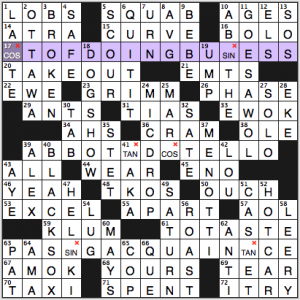
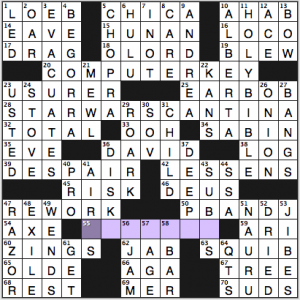
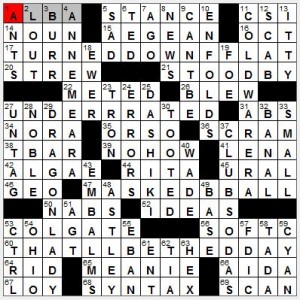
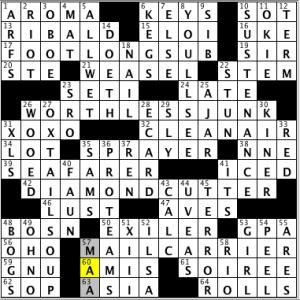
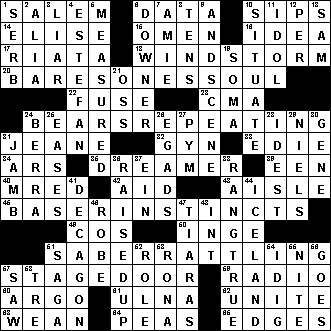
NYT: Rebus puzzles mess with my mind. As soon as I determine there’s a rebus, I question everything, and see the rebuses (rebi) everywhere. And that’s particularly true when there’s stuff I just didn’t know.
Example: Earbobs? Heaven knows I have enough of them, but had no idea they were called that. Especially that the word “bob” has, for me, the connotation of something short (as in bob haircuts) not dangling.
And I thought Squib meant an explosive, not a short news piece.
I finally got the theme, and admired it. But it was not an easy solve.
I enjoyed the Chen-Denny NYT puzzle. Second non-go-to LOEB this month, though [in addition to the two obvious ones you’ve mentioned, Amy, I am partial to Rockefeller Institute biologist Jacques, who was the model for the Gottlieb character in Sinclair Lewis’s “Arrowsmith.”] Re ANDREA Bargnani, he was after all the #1 pick in the 2006 NBA draft, and is now on the roster of the NY Knicks. Yes, this is the NY Times … but then again, many long-suffering Knicks fans would agree with you, Amy, “… never heard of him.”
Almost a pan-gram yes?
In the NY Times puzzle, that is
Loved the NYT theme entries.
First big misstep – assuming a rebus somewhere to fit PICARD into where AHAB belonged – yes we all wanted Picard! Most confused about: [Space bar, e.g.] clueing STARWARSCANTINA; [Star Wars cantina, e.g.] answers SPACEBAR but the reverse isn’t true!
Hence the question mark in the CANTINA clue. It’s being playful.
NYT — Started out hating it, ended up liking it. I think, given the vague clues, the intersection of 13d and 19a could be either a ‘W’ or a ‘D’ (though WS might say that “bod” is colloquial, unsignaled by the clue.)
Marshall Loeb is the best-known financial writer in captivity, which is not to say he’s well-known. He has written books, appeared on TV and edited (i.e. reworked rather than reworded!) every major financial magazine. If you shook me in the middle of the night and asked me to name a financial writer, he’d be the one. Never heard of Lisa, so I’m glad 1a was at least something I knew.
Maybe I have heard of Lisa. Vaguely rings a bell.
C’mon. That “Star Wars” setting is the CREATURE CANTINA. Same number of letters, too.
http://theswca.com/images-toys/figuretoys/cantina-front.jpg
Well of course that’s what they call it in the Star Wars universe. The rest of us call it the Star Wars cantina.
I really enjoyed the NYT today, not only for the fresh theme, but also for the fill, which I found challenging without being frustrating. Not too many obscure proper nouns there.
NYT: Reminded me of this cartoon, which made the internet rounds not that long a time ago, in this very galaxy:
My clever comment upon seeing it was, “In space, no one can hear you cry into your beer.”
I had a similar idea when I made this puzzle. The entry at 39A, with the “Star Wars” clue, was basically the seed.
http://www.xwordinfo.com/Crossword?date=8/16/2012
However, according to the XWord notes, the constructors conceived of today’s puzzle way back in 2010. They took the idea to a really cool place. Love it.
Some good rebi today!
However, I wouldn’t call the “Laffer CURVE” an “economics principle” any more than I’d call snake oil a “nutritional supplement.” Much quackery with either one.
I won’t express an opinion as to whether, under strict linguistic analysis, the Laffer curve qualifies as a “principle,” but the underlying issue Laffer was addressing — the relationship between rates of taxation and governmental revenues — is of monumental importance, and I am delighted to find in a puzzle this somewhat arcane reference to theoretical economics. In truth, the pragmatic, “cash value,” as William James would have put it, of this “principle” is pretty mundane and trivial. If rates of taxation are either too low, or too high, government revenues diminish. One is tempted to say “well DUH.” There is an ideal point somewhere in the middle. A little more analysis as to how to find that point would be nice. But still, it is a crucial conundrum and the entry was a welcome departure from the sort of thing one typically finds in crosswords.
There is plenty of serious work by economists on the relationship between taxes and government revenues, and the effect of tax rates on the economy. Important stuff, no doubt. But the Laffer curve wasn’t an example of serious academic research to determine optimal tax rates. It was a disingenuous tool of political propaganda used to justify lower tax rates (documented on a napkin, of all things, according to one story, which may be apocryphal). In short it has come to mean this: tax cuts pay for themselves. Lower tax rates will lead to a stronger economy and higher government revenues. Therefore: no need to worry about a budget deficit. That’s how the Reagan tax cuts were sold. What happened? The deficit exploded. The quacks had taken over.
Tax cuts have become the conservative solution to every economic problem that ails us. Time and again, the Laffer curve is trotted out as Exhibit A. That’s not because of sound economic principle, but rather for the benefit of a small number of people who spend a lot of money to influence public policy.
As a matter of fact, many economists who have done the research figure “optimal” top tax rates — i.e., maximizing economic effect and government revenues — to be in the neighborhood of 70% to 75%, give or take (which you could say skews more toward one end of the scale than “somewhere in the middle”). I wouldn’t argue rates should be that level, and politically it wouldn’t be possible anyway. Still, we have people claiming today’s rates, in the 20s and 30s, are too high, and that lower rates won’t increase the deficit. That’s just not true. It’s quackery.
I’m glad to see Laffer Curve make it into a puzzle too, Bruce. It’s had an influence on our economic policy for decades and is something educated people ought to know about. I know crosswords don’t normally take sides in political debates, but to clue it neutrally as an “economic principle” seems too generous and too distorted to me.
John, I do not disagree with, (or rather, I emphatically agree with), your political and analytical perspective, and especially with your last paragraph.
I majored in economics, but my first thought about the premise of the Laffer Curve was how it related to parimutuel wagering. In horse racing, the house takes its cut off the top and then pays out the rest to the winning bettors. Some thought that 20% takeout was too high and others that 10% was too low. The irony was that whatever the takeout was it didn’t matter because horse racing was too slow for today’s public. In slots, the return to the bettors is in the 98% range, but because of the volume of betting, the house take averages 20%. By the way, I agree with John’s analysis.
Steve
Submitted for your approval: my jottings from the puzzle zone:
BEQ: 69a SCAN meaning; 19d why question mark?
LAT: 15a, 58d.
Yours in obscurantism,
·p·
NYT: Cute theme! My software also didn’t like the empty squares and wanted me to type SPACE (or maybe it would have allowed just S?) into each square. I left ’em all blank. :-)
LAT: I’ve only heard the phrase “AND SCENE” used in a joking way, e.g., after a comedian (or an actor being funny) does a bit of acting or improv. So, I did not know that a director would ever say it. But I guess that’s where the joke comes from?